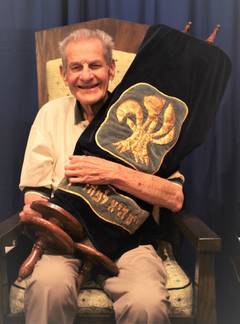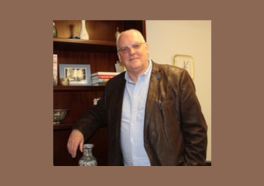- About Us
- Connect
- Learn
- Jewish Life
- Music
- Events
- Give
- Join Us
When the Earth Quakes
09/30/2016 03:10:43 PM
Rabbi Jennifer Jaech
| Author | |
| Date Added | |
| Automatically create summary | |
| Summary |
Rosh Hashanah Morning - 5776
Jewish tradition says that today, Rosh Hashanah, is “the birthday of the world.” Who doesn’t love birthdays? Candles burning on a cake, singing “Happy Birthday,” Pin the Tail on the Donkey -- Birthdays are joyous celebrations of the anniversary of a new life.
These happy customs are great when it comes to celebrating the birthdays of people. But I'm not sure that eating cake and singing are appropriate customs when it comes to celebrating the birthday of our world.
Science tells us that our world began in a manner far different than the birth of a child. Here is one description of the birth of the universe, taken from The Guardian's on-line science page. Pay close attention to the graphic language of this passage:
It all started with a tremendous bang. Somewhere in our galaxy a star exploded, throwing out masses of gas and dust. This supernova, as these explosions are called, happened about 5bn (billion) years ago. The wreckage from the explosion then crashed into a nearby cloud of gas, bringing together the ingredients for our solar system to form.[1]
Scientists tell us that the world began with violence: a bang, explosion, wreckage, crashes. And our world's violent beginnings are reflected in what happens on our planet today. Plates in our earth are still moving, pressing against and under each other, creating and releasing pressure, resulting in deadly earthquakes, landslides, and tsunamis.
The New Yorker[2] published an article this summer entitled: “The Really Big One.” The subtitle of the article was: “An earthquake will destroy a sizable portion of the coastal Northwest. The question is when.” The article included an illustration of a map of the Northwest, with Washington State and Oregon torn away. The caption indicated that this inevitable earthquake "will spell the worst natural disaster in the history of the continent.”
Guess where I was when I read this article? On an airplane headed to Seattle.
As I flew 600 miles per hour towards the Pacific Northwest, I read that my destination was roughly 100 years overdue for “the Really Big One." When it happens, “FEMA estimates that nearly 13,000 people will die in the Cascadia earthquake and tsunami. Another 27,000 will be injured, and (FEMA) expects that it will need to provide shelter for a million displaced people, and food and water for another two and a half million.”[3]
You might say that the New Yorker article about the Really Big One wasn’t the best choice of reading material to begin a summer vacation in the Northwest (and you would be right). But once I began reading it, I couldn’t put it down.
Many of you know that I have a strong connection to the Pacific Northwest. I grew up in Washington State and lived there well over half of my life. My grown son lives in Seattle, as do many other family members and friends. One of the reasons I like to visit the Northwest is that the land is strikingly beautiful and serene. But, apparently, appearances can be deceiving.
The night we arrived in Seattle, I couldn’t sleep. I kept thinking about the Really Big One. The article said that the Northwest does not have a warning system for earthquakes, so the first sign of impending disaster would be “a cacophony of barking dogs.” I lay awake and thought about the passage from the Unetaneh Tokef that we read earlier this morning: On Rosh Hashanah it is written and on Yom Kippur it is sealed: Who shall live and who shall die…who shall perish by fire and who by water…who by hunger and who by thirst, who by earthquake and who by plague.” Was it my fate to die by earthquake? I listened for the sound of barking dogs.
It is not in my nature to be overly fearful. Yet the thought of the Really Big One resurfaced regularly throughout my time in the Northwest this summer. Walking along the streets of Seattle, I tortured myself with the thought of my dear ones trapped under rubble. At a favorite retreat in the Cascades, I wondered if our lodge would slide down the mountain when the Really Big One hit. While walking on Oregon beaches, I found myself looking for escape routes should I have to outrun a tsunami. I stopped doing that after I had the grim realization that the Oregon coast will crumble into the ocean when the Really Big One hits, so if I happen to be on the beach when it happens, I probably wouldn't have to worry about a tsunami.
Through it all, I agonized over the question: Why is it so easy for negative thoughts to take root, and why is it so difficult to extirpate them? I could no longer trust myself to be courageous. Before reading the article, I considered myself a strong person, physically and mentally. But would I fall apart when the Really Big One hit?
I suspect that I am not alone. Many of us have a "Really Big One" that we fear. We are born into a world of danger, a world of accidents, diseases, terrorism and wars. We hear of tragedies happening to others and think: I could never live through that. And unlike the rest of the animal kingdom, our human brain prompts us to worry not only about the present, about what is happening, but also about the future -- about what might happen.
In the Jewish tradition we recite tehillim, Psalms, during a time of distress. Reading this ancient biblical poetry is meant to comfort us, to remind us that our ancestors endured terrible times too. One of my favorite Psalms is a well-known one: Psalm 23., the one that begins Adonai roi --“The Lord is my Shepherd.” My favorite line is gam ki aylaych b’gai tzalmavet, lo eera ra, ki atah imadi: “Though I walk through the valley of deepest darkness, I fear no harm, for You are with me.” These words remind me that although we sometimes must walk through valleys of deepest darkness, we do not walk through these valleys alone.
One afternoon last month we stopped for a drink at a place in Seattle’s Pike Place Market, a place that sells ginger beer. Its walls are lined with glass containers. While waiting in line to place an order, I found myself imagining what would happen if the Really Big One hit at that precise moment: The ground would undulate, the walls would teeter, and the glass containers would fall, shattering on the ground.
The thought of glass shards on the ground triggered a memory of a true story told to me by Lore Strauss, a member of our congregation. Lore lived during a time when the world around her shook and collapsed. But Lore's world didn't collapse because of geology, because of the movement of the earth's plates. Her world collapsed because of inhumanity, because of the impulse for brutality that is a sad part of the human condition.
In my imagination I see Lore as a girl, locked in her parents’ bedroom with her mother and brother. They are barefoot, wearing their nightclothes, listening to the sounds of her mother’s fine china shattering on the floor. The intruders smash the family’s piano and violin, shred all their clothing, cut the carpets into tatters, throw the books from the shelves, destroy every dish in the kitchen. Then water begins to seep in under the bedroom door. The intruders had turned on the bathroom faucets in order to flood the apartment.
In the morning, a Christian friend brought over shoes and clothing so the family could leave their destroyed home. Lore emerged in a post-Kristallnacht world, a world in which her uncle had been murdered, her synagogue burned down, and Jewish businesses in her community had been destroyed.
Lore's family fled Germany, escaping to France. When the Nazis invaded France, the family fled once more, leaving Paris and moving several times to stay one step ahead of round-ups. Sometimes the family had to split up, making Lore vulnerable to abuse by one family who had taken her in. But eventually the family was reunited and all its members received false identity papers.
Lore's family ended up in a remote village surrounded by farms, and it was there that she encountered someone who had connections with the resistance. At the age of nineteen, Lore moved into a house with other young adults who worked for the resistance. Lore could easily pass for German. She had blond hair, blue eyes, and spoke perfect French and German. Lore worked as a courier, delivering secret messages, and as a spy, sitting in coffeehouses and beer halls to overhear the conversations of German soldiers.
One day Lore had a tremendous scare. She returned to a village where she had delivered a secret message two weeks earlier, traveling by train. As Lore came out of the train station, she saw a poster with her photo on it. The poster identified her as someone wanted by the authorities. Lore tried not to walk fast or show any distress. She went two more blocks before slowly pulling a scarf over her hair, turning around and going back to the train station to leave town.
When Lore told me her story, I marveled at her courage. I asked her: how did you survive such a frightening time? Her response was simple and direct: "It was scary, but you got used to it. There is no way that you can be constantly scared and wait for something to happen. You somehow get used to it."
The memory of her words felt like a reassuring touch, a gesture of consolation. I thought of those in our congregation who have faced their own Really Big Ones, those who have faced debilitating illnesses and devastating losses. Within our own congregation are many courageous people who have endured terrible times. Their example is an inspiration to me.
And I thought of our Jewish people, our ancestors who walked through "the valley of deepest darkness"[4] time and again in the course of our history. We are a people who emerge from the dark valleys we must traverse. We emerge, we regroup, and we walk on. Perhaps we are each made of stronger stuff than we realize.
This day we remember the world’s creation, its violent origin. We live on a planet that was, and will be, shaken by catastrophes both natural and man-made. But we are also born with the capacity to endure, even to thrive. We might not discover this capacity until the earth shakes and we are tested. But if that should happen, we know we can reach for the hands of those around us. We do not walk through the valley of deepest darkness alone. Our God works through the love of those who surround us. And as long as we walk together, we will face what we must with strength and with grace.
Thu, April 24 2025
26 Nisan 5785
Temple israel Happenings
-
Thursday ,
AprApril 24 , 2025 County-Wide Yom HaShoah Commemoration
County-Wide Yom HaShoah Commemoration
Thursday, Apr 24th 12:00pm to 1:00pm
County-Wide Yom HaShoah Commemoration at the Garden of Remembrance, 119 Martine Avenue in White Plains. Temple Israel's rescued Holocaust Torah scroll will be part of the procession of scrolls from Westchester county, and Cantor Hayley Kobilinsky will participate in the program. -
Tuesday ,
AprApril 29 , 2025 Sisterhood Book Group
Sisterhood Book Group
Tuesday, Apr 29th 6:00pm to 8:30pm
NEW DATE! We will be discussing the book "The Frederick Sisters Are Living the Dream" by Jeannie Zusy in person at a congregants' home. The author will be joining us for the discussion. We will have a Pot Luck Dinner to start -
Wednesday ,
AprApril 30 , 2025 Holocaust Education Today: Challenges and Limits by Dr. Werner Steger
Holocaust Education Today: Challenges and Limits by Dr. Werner Steger
Wednesday, Apr 30th 6:00pm to 7:30pm
Dr. Steger serves as the endowed chair for the Greenspan-Handel Trust for Holocaust and Genocide Studies. -
Saturday ,
MayMay 3 , 2025 Midnight Run
Midnight Run
Shabbat, May 3rd 1:00pm to 4:00pm
Volunteers needed. The Midnight Run is a volunteer organization whose goal is to come together as a community in order to feed the homeless of New York City. They coordinate more than 1,000 relief missions per year with volunteers from churches, synagogues, schools and other civic groups to deliver food, clothing, blankets and personal care items to the homeless poor on the streets of New York City.
Events
Today's Calendar
| Yom HaShoah |
: 12:00pm |
: 7:00pm |
Friday Night
: 7:00pm |
Shabbat Day
: 9:30am |
Upcoming Programs & Events
Apr 24 |
Apr 24 |
Apr 29 |
Apr 30 |
May 2 |
This week's Torah portion is Parashat Sh'mini
| Shabbat, Apr 26 |
Yom HaShoah
| Thursday, Apr 24 |




